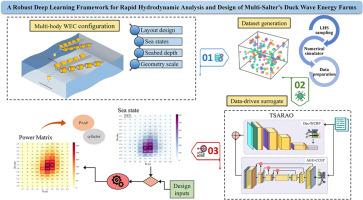A robust deep learning framework for rapid hydrodynamic analysis and design of multi-Salter's duck wave energy farms
IF 5.5
2区 工程技术
Q1 ENGINEERING, CIVIL
引用次数: 0
Abstract
Ocean wave energy offers substantial potential for sustainable power generation, but designing efficient wave energy converter (WEC) farms faces high computational costs from complex hydrodynamic simulations. This study presents a novel deep learning-based surrogate modeling framework to accelerate the analysis and design of multi-Salter's duck WEC arrays. It decomposes hydrodynamic response prediction into two stages: first, estimating individual multi-Salter's duck unit dynamics, then predicting interaction effects between neighboring units. Specialized deep learning architectures for each stage were optimized via neural architecture search (NAS) and trained on a comprehensive dataset spanning diverse design parameters, array configurations, and environmental conditions. Against nine tuned benchmarks, our framework achieved a 19.3 % reduction in mean absolute error (MAE) for individual unit dynamics and a 62.5 % MAE reduction for interaction effects compared to the best-performing benchmarks. A case study using realistic wave climates from southeast Australia validated the model's accuracy in predicting annual average power absorption and interaction factors, while drastically reducing computational time relative to traditional numerical methods. This efficient and accurate surrogate model enables optimized co-design and advances the feasibility of large-scale wave energy deployment.

一个强大的深度学习框架,用于快速水动力分析和设计多索尔特鸭波能农场
海浪能为可持续发电提供了巨大的潜力,但设计高效的波浪能转换器(WEC)农场面临着复杂流体动力学模拟的高计算成本。本文提出了一种新的基于深度学习的代理建模框架,以加速多索尔特鸭WEC阵列的分析和设计。将水动力响应预测分为两个阶段:首先估算单个多索尔特鸭单元的动力,然后预测相邻单元之间的相互作用效应。每个阶段的专业深度学习架构都通过神经架构搜索(NAS)进行优化,并在涵盖不同设计参数、阵列配置和环境条件的综合数据集上进行训练。与性能最好的基准测试相比,我们的框架在单个单元动态的平均绝对误差(MAE)上降低了19.3%,在交互效果上降低了62.5%。一个使用澳大利亚东南部真实波浪气候的案例研究验证了该模型在预测年平均功率吸收和相互作用因子方面的准确性,同时相对于传统数值方法大大减少了计算时间。这种高效、准确的替代模型可以优化协同设计,提高大规模波浪能部署的可行性。
本文章由计算机程序翻译,如有差异,请以英文原文为准。
求助全文
约1分钟内获得全文
求助全文
来源期刊

Ocean Engineering
工程技术-工程:大洋
CiteScore
7.30
自引率
34.00%
发文量
2379
审稿时长
8.1 months
期刊介绍:
Ocean Engineering provides a medium for the publication of original research and development work in the field of ocean engineering. Ocean Engineering seeks papers in the following topics.
 求助内容:
求助内容: 应助结果提醒方式:
应助结果提醒方式:


